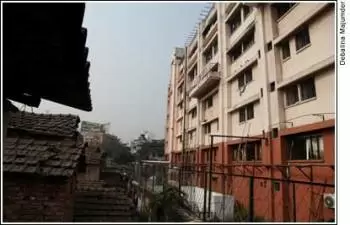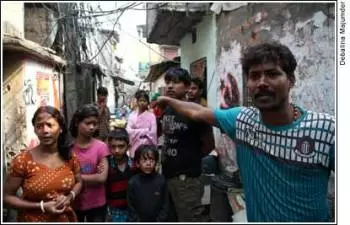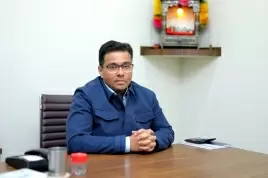Residents of Panchanantala slum for once proved that they are not a nuisance
15-December-2011
Vol 2 | Issue 50
The very residents of the Panchanantala slum in Kolkata who are considered a nuisance by the occupants of the high-rises that surround them, who are periodically threatened with eviction and turned away even in emergencies by the specialty AMRI Hospital next door to them, risked their lives to rescue patients from the burning hospital.
It was business as usual in Panchanantala slum in South Kolkata that afternoon. Men were at work, some hawking fruit or sawing pieces of wood, others grabbing a siesta before returning to work.
 |
|
People from the local slum risked their lives to rescue patients trapped in the inferno
|
Women busied themselves washing utensils or clothes in front of their home while children shouted with laughter, disappearing through the maze of crowded lanes crisscrossing the rows of shanties.
Teenage girls dressed in printed gowns went about their daily chores, barely casting a glance at strangers like us wading through the garbage and puddles of water, a little lost and unsure.
The routine ordinariness in Panchanantala concealed the fact that less than 34 hours ago, these very same people had sprung into action to create history of sorts: men, women and children had emerged from their shanties and rushed, spontaneously risking their own lives, to rescue patients trapped in a high-rise hospital building engulfed in poisonous smoke.
December 9 dawned ominously upon the city with more than 90 people suffocating to death in a hi-tech hospital, the worst tragedy in a medical institution in the country.
When in the wee hours of Friday, two women in the slum smelt smoke and were alerted by the screams for help from patients of the hospital overlooking the slum, they immediately raised an alarm.
It was a little past 2 am, but within minutes young boys and middle-aged men from the slum rushed to the gates of the Advanced Medical Research Institute (AMRI), a well-known hospital in south Calcutta, to help rescue operations, only to be rudely turned away by the hospital security guards who bolted the gates to prevent their entry.
“We implored the guards that there was a fire and patients were crying for help. They said they were taking care of the situation and demanded that we leave,” said Bappa Das, a class X student in the local school.
Undeterred, the men cut through the barbed wire and made a hole with shovels in the 10-feet-high brick wall surrounding the hospital and separating it from the slum.
Even as a blanket of thick smoke engulfed the annex of AMRI where serious patients in special care units and orthopaedic cases were housed, the men constructed crude bamboo ladders to climb the high walls and women made ropes of their saris and dupattas to aid the effort.
Two hours later, at 4 am, the fire brigade arrived with manual ladders and no breathing apparatus. But even before the fire brigade and the police could get into the act of rescuing patients from the top floors of the hospital, the slumdwellers had scampered to the top floor on bamboo poles, water pipes and wooden ladders rushed from the slum, and braved the blinding smoke to drag out patients who were gasping for breath.
In the din and chaos of darkness enveloped by the poisonous gas and screaming patients, groups of slumdwellers joined by the fire brigade, police and some hospital staff realised the worst-affected were the patients on the fourth floor, surrounded by monitors and drips and innumerable medical equipment.
“We could see all around us the evidence of patients who had dragged themselves to the windows and shattered the glass panes in order to breathe and escape death, but had failed,” said Bappa.
Many patients survived the trauma and were rushed to nearby hospitals, others were not so lucky. Among the dead were two young nurses from Kerala who made valiant efforts to save their patients while two young boys of Panchanantala’s rescue team are still battling for life in a city hospital.
Senior officials both from the police and fire departments have acknowledged the role played by the locals in saving the lives of many AMRI patients. “They were with us throughout the day, evacuating the patients and reaching the hospital gates long before us,” admitted a senior police officer of the local Lake thana.
It was the local slumdwellers, against whom the high walls of the hospital were built, who proved to be the saviours, the Good Samaritans, that fateful morning.
Gurupada Mandal, a mason, was watching Vidya Balan gyrating in The Dirty Picture promos on TV when we met him on Saturday afternoon sitting on a bed that covered the matchbox-sized room.
Hiding his annoyance at being disturbed, he did not understand why he should be interviewed for what he thought was an ordinary act. “My wife woke me up and urged me to go and help patients who were screaming for help. Without thinking I ran and called my neighbour. Together, we took a shovel to break a hole in the wall. Since I am a mason I have bamboo poles and with some rope we tied them together and made a ladder to climb the hospital building,” said Mandal in a matter-of-fact tone.
Raju Bhandari and his friends were among the first to climb up the back of the hospital building on the bamboo scaffolding that was left standing for hospital renovation.
They saw patients on the second and third floors banging desperately on the window panes to shatter the glass. Fourteen-year-old Akhoy Lal, a school dropout, said it was tough bringing those who could not move or walk down the makeshift ladder.
 |
|
Fire officials acknowledge the role of slumdwellers in the rescue efforts
|
“Many patients were already dead by the time they were dragged out,” said Akhoy who moved away embarrassed when others pointed to the injury he had suffered on his left shoulder.
India’s National Building Code has more than 80 pages on fire safety. It also recommends a technology that prevents fumes from travelling through the AC ducts as happened in the recent fire.
At AMRI Hospital, the fire actually broke out in the basement, but the deadly smoke travelled through the AC ducts to the floors above. The basement that was meant for parking cars was being used as a storage facility in alleged violation of guidelines.
Fire officials told the media that they had sent notices to the hospital for using the basement to store housekeeping equipment and materials to power back-up units, converting it into a veritable storehouse of inflammable, combustible material.
Moreover, the annex where the fire broke out does not have a ramp to evacuate patients in case of emergency and the building is built on a strip of land squeezed between the Panchanantala slum and another hospital building closely surrounded by a wall that prevents free access for the fire brigade. Despite the information about the lapses and the lack of preparedness on the part of AMRI to fight fire, the fire and emergency department issued a no-objection certificate on August 29.
In a swift move, the Chief Minister of Bengal, Mamata Banerjee, has ordered both a judicial and police probe into the AMRI tragedy, cancelled the license of the AMRI annex and had the six hospital directors arrested. - Infochange News & Features
















